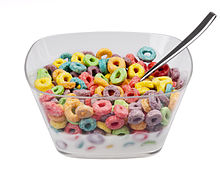Ultra-processed food
It has been suggested that this article be merged with Hyperpalatable food to Nova classification. (Discuss) Proposed since March 2024. |
This article has multiple issues. Please help improve it or discuss these issues on the talk page. (Learn how and when to remove these template messages)
|


Ultra-processed food (UPF) is an industrially formulated edible substance derived from
The state of research into ultra-processed foods and their effects is evolving rapidly as of 2024.[4][5] Epidemiological data suggest that consumption of ultra-processed foods is associated with higher risks of many diseases, including obesity, type 2 diabetes, cardiovascular diseases, and specific cancers.[6] Additionally, growing bodies of data point to food addiction associated with consumption of ultra-processed foods, especially among youth.[7][8][9] Also, researchers present ultra-processing as a facet of environmental degradation caused by the food industry.[10]
Definitions
Concerns around food processing have existed since at least the Industrial Revolution.[11] Many critics identified 'processed food' as problematic, and movements such as raw foodism attempted to eschew food processing entirely, but since even basic cookery results in processed food, this concept failed in itself to influence public policy surrounding the epidemiology of obesity.[citation needed]
Michael Pollan's influential book The Omnivore's Dilemma referred to highly processed industrial food as 'edible food-like substances'.[12] Carlos Augusto Monteiro cited Pollan as an influence in coining the term 'ultra-processed food' in a 2009 commentary.[13] Monteiro's team developed the Nova classification for grouping unprocessed and processed foods beginning in 2010, whose definition of ultra-processing has become most widely accepted and has gradually become more refined through successive publications.[14] The identification of ultra-processed foods, as well as the category itself, is a subject of debate among nutrition and public health scientists, and other definitions have been proposed.[15]
A survey of systems for classifying levels of food processing in 2021 identified four 'defining themes':
- Extent of change (from natural state);
- Nature of change (properties, adding ingredients);
- Place of processing (where/by whom);
- Purpose of processing (why, essential/cosmetic).[16]
Of the various systems they surveyed, the researchers found that only the Nova classification takes all four themes into account.
Monteiro's 2009 commentary
Carlos Monteiro, working with a team of researchers at the University of São Paulo, first published the concept of ultra-processed foods in a 2009 invited commentary for Public Health Nutrition:
Ultra-processed foods are basically confections of group 2 ingredients [substances extracted from whole foods], typically combined with sophisticated use of additives, to make them edible, palatable, and habit-forming. They have no real resemblance to group 1 foods [minimally processed foods], although they may be shaped, labelled and marketed so as to seem wholesome and 'fresh'. Unlike the ingredients included in group 2, ultra-processed foods are typically not consumed with or as part of minimally processed foods, dishes and meals. On the contrary, they are designed to be ready-to-eat (sometimes with addition of liquid such as milk) or ready-to-heat, and are often consumed alone or in combination (such as savoury snacks with soft drinks, bread with burgers).[13]
This definition is as much social as one based on specific ingredients, which makes the understanding of ultra-processed foods highly intuitive, even among untrained consumers.[17][18] A letter responding to Monteiro's 2009 commentary suggested that the definition 'lacks precision', since it lacks the measurable definitions of traditional food science.[19] Because of this, researchers disagree whether the definition can form a valid basis for scientific control.[20] Researchers have developed a quantitative definition for hyperpalatable food, but not for ultra-processed food.[21]
Nova classification

Monteiro's team subsequently presented ultra-processed foods as a group in the Nova food classification system.[22] The system focuses on food processing rather than foods types or nutrients. Nova categorizes foods into four groups:[3]
- Unprocessed or minimally processed foods
- Processed culinary ingredients
- Processed foods
- Ultra-processed foods
Nova is an open classification that refines its definitions gradually through new scientific publications rather than through a central advisory board.[14] The most recent overview of Nova published with Monteiro defines ultra-processed food as follows:
Industrially manufactured food products made up of several ingredients (formulations) including sugar, oils, fats and salt (generally in combination and in higher amounts than in processed foods) and food substances of no or rare culinary use (such as
The Nova definition of ultra-processed food does not comment on the nutritional content of food and is not intended to be used for nutrient profiling.[24]
International Agency for Research on Cancer (IARC)
The International Agency for Research on Cancer, an intergovernmental agency that forms part of the World Health Organization, classifies foods by their degree of processing. This system breaks food into 'non-processed', 'moderately processed', and 'highly processed' food.[25] The system does not take into account the nature or purpose of changes.[26]
Siga Index
The Siga Index is a classification system for processed foods developed in France in 2018.[27] It is based on both the degree of processing and the nutritional quality of foods, using a holistic and reductionist approach.[28]
The Siga Index assigns a score from 1 to 100 to each food product, where higher scores indicate higher nutritional quality and lower processing. The Siga Index also defines ultra-processed foods (UPFs) as those with a score below 40, which are considered to have low nutritional value and high levels of additives, preservatives, and artificial ingredients.[29]
International Food Information Council (IFIC)
The International Food Information Council defines five levels of food processing:[30][31]
- Minimally processed
- Foods processed for preservation
- Mixtures of combined ingredients
- Ready-to-eat processed foods
- Prepared foods/meals
NUPENS
The Center for Epidemiological Research in Nutrition and Health at the University of São Paulo has proposed a variant on the Nova classification consisting of:[32]
- Unprocessed, minimally, or moderately processed foods
- Processed foods
- Ultra-processed foods
Economics

Ultra-processed foods are an important part of the portfolio of the
Health effects
The effect of ultra-processed foods on health has mainly been investigated using nutritional epidemiology and so far there has been no randomized controlled trial to investigate the effect of these foods on any health outcome other than weight gain. These studies have shown an overall increased risk for disease,[6][36] although studies separating different types of ultra-processed food have found adverse affects mainly for only some sub-groups such as soft drinks.[37] Overall, there is an association between certain poor health outcomes – including poor cardiometabolic and mental health, and reduced life expectancy – and consumption of UPF.[4]
One possible explanation for the adverse effect on health are the high amounts of sugar, fat and salt in these foods, although that does not apply to all ultra-processed foods. Other potential explanations are the presence of contaminants, certain food additives, and the high heat treatment of these foods.[38] There is currently however no scientific consensus.[39]
Environmental impact
Beyond health implications, the production of ultra-processed foods also has significant environmental impacts.[10] These foods require extensive processing and packaging, resulting in higher energy consumption and waste production compared to minimally processed foods. Moreover, the globalized supply chains for the ingredients of ultra-processed foods contribute to greenhouse gas emissions.[40]
Regulation and policy
Given the health and environmental impacts of ultra-processed foods, there have been calls for better regulation and policy surrounding these products. These measures face significant challenges, including industry opposition and the global nature of food supply chains. Future policy efforts may require a combination of regulation, education, and incentives to promote healthier, more sustainable food choices.
Four Latin American countries—Brazil,[41] Uruguay,[42] Peru,[43] and Ecuador[44]—have so far published national official dietary guidelines that recommend avoiding ultra-processed foods. Chile requires warning labels on some ultra-processed foods and taxes sugar-sweetened beverages.[45] A report on obesity published by the World Bank in 2020 mentions ultra-processed foods as a potential contributor.[46]
In 2022, the Scientific Advisory Committee on Nutrition (SACN) reviewed scientific literature to consider whether the British government should adopt a position on ultra-processed food and recommended further research, scheduling a review on its position for June 2024.[39]
Criticism
Following the publication of the Nova classification, some researchers questioned whether food processing should itself be considered a factor in nutrient intake, especially in a prominent 2017 criticism written by researchers, one of which was funded by Nestlé and the Kerry Group.[47] UPFs are imprecisely defined and it is unclear how any adverse effects on health may come about.[48]
In 2022, Carlos Monteiro and Arne Astrup argued for and against the Nova classification in a series of three articles written in the style of an
The recommendation to prefer unprocessed/minimally processed foods and freshly made meals instead of ultra-processed foods (following the Nova food classification system) is being increasingly adopted in new official dietary guidelines issued by national governments and international health associations. This recommendation is supported by systematic reviews and meta-analyses of nationally representative dietary surveys and long-term cohort studies. These data show that increased intake of ultra-processed foods is associated with poor-quality diets and with increased morbidity and mortality from several chronic diseases. Various attributes of ultra-processed foods acting through known, plausible, or suggested physiologic and behavioral mechanisms relate them to ill health, and it is likely that different combinations of attributes and mechanisms affect different health outcomes. Although more research should be done to identify these mechanisms, existing evidence is sufficient to recommend the avoidance of ultra-processed foods to optimize health and policies to support and make feasible this recommendation.[49]
Astrup's 'no' argument centres on the Nova definition of ultra-processed foods as not yet sufficiently proven by scientific research for broad application in public health policy:
Clearly, many aspects of food processing can affect health outcomes, but conflating them into the notion of ultra-processing is unnecessary, because the main determinants of chronic disease risk are already captured by existing nutrient profiling systems. In conclusion, the Nova classification adds little to existing nutrient profiling systems; characterizes several healthy, nutrient-dense foods as unhealthy; and is counterproductive to solve the major global food production challenges.[50]
The two researchers nonetheless share consensus that further study is required to understand the effect of food processing on human health:
The participants in this debate agree that food processing vitally affects human health, and that the extent of food processing significantly affects diet quality and health outcomes. They disagree on the significance of ultra-processing, as defined within the Nova food classification system.[51]
See also
References
- ISSN 2041-9775.
- ISSN 2041-9775.
- ^ PMID 30744710.
- ^ PMID 38418082.
- PMID 37813465.
- ^ PMID 32792031.
- PMID 30439381.
- PMID 35921867.
- PMID 36349805.
- ^ PMID 35346976.
- S2CID 23606942.
- ISBN 978-1-59420-082-3.
- ^ S2CID 42136316.
- ^ PMID 30820487.
- S2CID 203896042.
- S2CID 233647428.
- S2CID 259941132.
- S2CID 3554621.
- S2CID 233340283.
- S2CID 249923737.
- S2CID 207899275.
- PMID 21180977.
- S2CID 259024679.
- S2CID 258618401.
- S2CID 23413731.
- PMID 19888275.
- PMID 29860978.
- S2CID 211231016.
- S2CID 187435561.
- PMID 25578928.
- PMID 22990468.
- PMID 26231112.
- S2CID 57559050.
- S2CID 13735684.
- PMID 28322183.
- S2CID 257872002.
- PMID 36854188.
- PMID 35236935.
- ^ a b Scientific Advisory Committee on Nutrition (2023-07-11). "SACN statement on processed foods and health". GOV.UK.
- S2CID 222280757.
- ^ Dietary Guidelines for the Brazilian Population (Report). Brasília: Brazilian Ministry of Health. 2014.
- ^ "Guías Alimentarias para la Población Uruguaya". Montevideo: Ministerio de Salud del Uruguay. 2016.
- ^ Guías Alimentarias para la Población Peruana (Report). Lima: Ministerio de Salud del Perú. 2018.
- ^ Documento Técnico de las Guías Alimentarias Basadas en Alimentos (GABA) del Ecuador. GABA-ECU (Report). Quito: Ministerio de Salud Pública del Ecuador y Organización de las Naciones Unidas para la Alimentación y la Agricultura. 2018.
- PMID 34855853.
- S2CID 219141840.
- PMID 28793996.
- S2CID 239986991.
- PMID 35670127.
- PMID 35670128.
- PMID 36253965.
